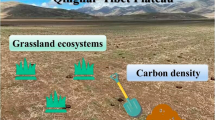Abstract
The tree species composition has a significant impact on the biogeochemical cycle of forest ecosystems, which in turn affects nutrient leaching and stream water quality. We have formulated a hypothesis that nutrient leaching varies depending on the tree species composition owing to the properties of surface soil chemistry characterized by the tree species composition. To test this hypothesis, we have collected soil water samples below the root zone in Japanese cedar plantations (CF) and natural forests (NF) and compared nutrient leaching. We analyzed major ion chemical characteristics, net N mineralization, and net nitrification in the surface soil (A layer) to determine possible causes for differences in nutrient leaching. Our results revealed that calcium (Ca2+) and nitrate (NO3−) concentrations in soil water below the root zone were significantly higher in CF than in NF. Additionally, the Ca2+ and NO3− contents in surface soil were higher in CF than in NF, which may explain the higher concentrations of Ca2+ and NO3− in soil water in CF. In contrast, there was no significant difference in soil net nitrification rates between CF and NF. Correlations between NO3− and Ca2+ concentrations in soil solution suggest that the higher availability of Ca2+ from surface soils in CF could partially account for the higher NO3− leaching from CF. Our study suggests that the properties of surface soil chemistry characterized by the tree species composition are responsible for causing the differences in nutrient leaching.


Similar content being viewed by others
References
Augusto L, Ranger J, Binkley D, Rothe A (2002) Impact of several common tree species of European temperate forests on soil fertility. Ann for Sci 59:233–253
Augusto L, De Schrijver A, Vesterdal L, Smolander A, Prescott C, Ranger J (2015) Influences of evergreen gymnosperm and deciduous angiosperm tree species on the functioning of temperate and boreal forests. Biol Rev Camb Philos Soc 90:444–466. https://doi.org/10.1111/brv.12119
Baba M, Kato M, Sugiura T, Kobayashi H (2004) Calcium accumulation alleviates soil acidification in Japanese Cedar (Cryptomeria japonica) stands. Soil Sci Plant Nutr 50:403–411
Bengtsson G, Bengtson P, Månsson KF (2003) Gross nitrogen mineralization-, immobilization-, and nitrification rates as a function of soil C/N ratio and microbial activity. Soil Biol Biochem 35:143–154. https://doi.org/10.1016/S0038-0717(02)00248-1
Binkley D, Giardina C (1998) Why do tree species affect soils? The warp and woof of tree–soil interactions. Biogeochemistry 42:89–106. https://doi.org/10.1023/A:1005948126251
Chiu Y-C, Lee L-L, Chang C-N, Chao AC (2007) Control of carbon and ammonium ratio for simultaneous nitrification and denitrification in a sequencing batch bioreactor. Int Biodeterior Biodegrad 59:1–7. https://doi.org/10.1016/j.ibiod.2006.08.001
Chiwa M (2021) Long-term changes in atmospheric nitrogen deposition and stream water nitrate leaching from forested watersheds in western Japan. Environ Pollut 287:117634. https://doi.org/10.1016/j.envpol.2021.117634
Chiwa M, Maruno R, Ide J, Miyano T, Higashi N, Otsuki K (2010) Role of stormflow in reducing N retention in a suburban forested watershed, western Japan. J Geophys Res Biogeosci 115:G02004. https://doi.org/10.1029/2009jg000944
Chiwa M, Onikura N, Ji I, Kume A (2012) Impact of N-saturated upland forests on downstream N pollution in the Tatara River Basin, Japan. Ecosystems 15:230–241
Chiwa M, Saito T, Haga H, Kato H, Otsuki K, Onda Y (2015) A nitrogen-saturated plantation of Cryptomeria japonica and Chamaecyparis obtusa in Japan is a large nonpoint nitrogen source. J Environ Qual 44:1225. https://doi.org/10.2134/jeq2014.09.0401
Chiwa M, Tateno R, Hishi T, Shibata H (2019) Nitrate leaching from Japanese temperate forest ecosystems in response to elevated atmospheric N deposition. J for Res 24:1–15. https://doi.org/10.1080/13416979.2018.1530082
Christ MJ, Driscoll CT, Likens GE (1999) Watershed- and plot-scale tests of the mobile anion concept. Biogeochemistry 47:335–353. https://doi.org/10.1007/BF00992913
De Schrijver A, Geudens G, Augusto L, Staelens J, Mertens J, Wuyts K, Gielis L, Verheyen K (2007) The effect of forest type on throughfall deposition and seepage flux: a review. Oecologia 153:663–674
Ding W, Tsunogai U, Nakagawa F, Sambuichi T, Chiwa M, Kasahara T, Shinozuka K (2023) Stable isotopic evidence for the excess leaching of unprocessed atmospheric nitrate from forested catchments under high nitrogen saturation. Biogeosciences 20:753–766. https://doi.org/10.5194/bg-20-753-2023
Dise NB, Wright RF (1995) Nitrogen leaching from European forests in relation to nitrogen deposition. For Ecol Manage 71:153–161
Donaldson JM, Henderson GS (1990) Nitrification potential of secondary-succession upland oak forests: I. Mineralization and nitrification during laboratory incubations. Soil Sci Soc Am J 54:892–897. https://doi.org/10.2136/sssaj1990.03615995005400030047x
Eno CF (1960) Nitrate production in the field by incubating the soil in polyethylene bags. Soil Sci Soc Am J 24:277–279
Gundersen P, Emmett BA, Kjonaas OJ, Koopmans CJ, Tietema A (1998) Impact of nitrogen deposition on nitrogen cycling in forests: a synthesis of NITREX data. For Ecol Manage 101:37–55
Gundersen P, Schmidt IK, Raulund-Rasmussen K (2006) Leaching of nitrate from temperate forests—effects of air pollution and forest management. Environ Rev 14:1–57. https://doi.org/10.1139/a05-015
Inagaki Y, Kohzu A (2005) Microbial immobilization and plant uptake of different N forms in three forest types in Shikoku district, southern Japan. Soil Sci Plant Nutr 51:667–670. https://doi.org/10.1111/j.1747-0765.2005.tb00087.x
Inagaki Y, Miura S (2002) Soil NO3-N production and immobilization affected by NH4-N, glycine, and NO3-N addition in different forest types in Shikoku, southern Japan. Soil Sci Plant Nutr 48:679–684
Kauffman SJ, Royer DL, Chang S, Berner RA (2003) Export of chloride after clear-cutting in the Hubbard Brook sandbox experiment. Biogeochemistry 63:23–33. https://doi.org/10.1023/A:1023335002926
Kavvadias VA, Alifragis D, Tsiontsis A, Brofas G, Stamatelos G (2001) Litterfall, litter accumulation and litter decomposition rates in four forest ecosystems in northern Greece. For Ecol Manage 144:113–127. https://doi.org/10.1016/S0378-1127(00)00365-0
Kristensen HL, Gundersen P, Callesen I, Reinds GJ (2004) Throughfall nitrogen deposition has different impacts on soil solution nitrate concentration in European coniferous and deciduous forests. Ecosystems 7:180–192
Lovett GM, Weathers KC, Arthur MA (2002) Control of nitrogen loss from forested watersheds by soil carbon: nitrogen ratio and tree species composition. Ecosystems 5:712–718
Ohta T, Niwa S, Hiura T (2014) Calcium concentration in leaf litter affects the abundance and survival of crustaceans in streams draining warm-temperate forests. Freshw Biol 59:748–760. https://doi.org/10.1111/fwb.12301
Ohta T, Shin K-C, Saitoh Y, Nakano T, Hiura T (2018) The effects of differences in vegetation on calcium dynamics in headwater streams. Ecosystems 21:1390–1403. https://doi.org/10.1007/s10021-018-0229-1
Oyanagi N, Chihara M, Toda H, Haibara K (2002) Characteristics of carbon and nitrogen mineralization of forest soils in different slopes and vegetation. J Jpn for Soc 84:111–119 (in Japanese with English summary)
Page BD, Mitchell MJ (2008) Influences of a calcium gradient on soil inorganic nitrogen in the Adirondack Mountains, New York. Ecol Appl 18:1604–1614. https://doi.org/10.1890/07-0150.1
Phillips RP, Brzostek E, Midgley MG (2013) The mycorrhizal-associated nutrient economy: a new framework for predicting carbon-nutrient couplings in temperate forests. New Phytol 199:41–51. https://doi.org/10.1111/nph.12221
Reich PB, Oleksyn J, Modrzynski J, Mrozinski P, Hobbie SE, Eissenstat DM, Chorover J, Chadwick OA, Hale CM, Tjoelker MG (2005) Linking litter calcium, earthworms and soil properties: a common garden test with 14 tree species. Ecol Lett 8:811–818. https://doi.org/10.1111/j.1461-0248.2005.00779.x
Rosi-Marshall EJ, Bernhardt ES, Buso DC, Driscoll CT, Likens GE (2016) Acid rain mitigation experiment shifts a forested watershed from a net sink to a net source of nitrogen. Proc Natl Acad Sci USA 113:7580–7583. https://doi.org/10.1073/pnas.1607287113
Rothe A, Mellert KH (2004) Effects of forest management on nitrate concentrations in seepage water of forests in southern Bavaria, Germany. Water Air Soil Pollut 156:337–355
Rothe A, Huber C, Kreutzer K, Weis W (2002) Deposition and soil leaching in stands of Norway spruce and European Beech: results from the Höglwald research in comparison with other European case studies. Plant Soil 240:33–45. https://doi.org/10.1023/A:1015846906956
Schlesinger WH, Bernhardt ES (2020) Biogeochemistry: an analysis of global change, 4th edn. Elsevier, New York
Shinozuka K, Chiwa M, Tayasu I, Yoshimizu C, Otsuki K, Kume A (2017) Differences in stream water nitrate concentrations between a nitrogen-saturated upland forest and a downstream mixed land use river basin. Hydrology. https://doi.org/10.3390/hydrology4030043
Takagi M (2015) Water chemistry of headwater streams under stormflow conditions in catchments covered by evergreen broadleaved forest and by coniferous plantation. Landsc Ecol Eng 11:293–302. https://doi.org/10.1007/s11355-014-0269-4
Tanikawa T, Sobue A, Hirano Y (2014) Acidification processes in soils with different acid buffering capacity in Cryptomeria japonica and Chamaecyparis obtusa forests over two decades. For Ecol Manage 334:284–292. https://doi.org/10.1016/j.foreco.2014.08.036
Tanikawa T, Ito Y, Fukushima S, Yamashita M, Sugiyama A, Mizoguchi T, Okamoto T, Hirano Y (2017) Calcium is cycled tightly in Cryptomeria japonica stands on soils with low acid buffering capacity. For Ecol Manage 399:64–73. https://doi.org/10.1016/j.foreco.2017.04.022
Tateno R, Fukushima K, Fujimaki R, Shimamura T, Ohgi M, Arai H, Ohte N, Tokuchi N, Yoshioka T (2009) Biomass allocation and nitrogen limitation in a Cryptomeria japonica plantation chronosequence. J for Res 14:276–285. https://doi.org/10.1007/s10310-009-0135-7
Thimonier A, Pannatier EG, Schmitt M, Waldner P, Walthert L, Schleppi P, Dobbertin M, Krauchi N (2010) Does exceeding the critical loads for nitrogen alter nitrate leaching, the nutrient status of trees and their crown condition at Swiss long-term forest ecosystem research (LWF) sites? Eur J for Res 129:443–461. https://doi.org/10.1007/s10342-009-0328-9
Watanabe M, Takamatsu T, Koshikawa MK, Yamamura S, Inubushi K (2008) Dry deposition of acidic air pollutants to tree leaves, determined by a modified leaf-washing technique. Atmos Environ 42:7339–7347. https://doi.org/10.1016/j.atmosenv.2008.07.015
Watanabe M, Miura S, Hasegawa S, Koshikawa MK, Takamatsu T, Kohzu A, Imai A, Hayashi S (2018) Coniferous coverage as well as catchment steepness influences local stream nitrate concentrations within a nitrogen-saturated forest in central Japan. Sci Total Environ 636:539–546. https://doi.org/10.1016/j.scitotenv.2018.04.307
Wilpert K, Zirlewagen D, Kohler M (2000) To what extent can silviculture enhance sustainability of forest sites under the immission regime in Central Europe? Water Air Soil Pollut 122:105–120. https://doi.org/10.1023/A:1005275219108
Wuyts K, De Schrijver A, Staelens J, Van Nevel L, Adriaenssens S, Verheyen K (2011) Soil inorganic N leaching in edges of different forest types subject to high N deposition loads. Ecosystems 14:818–834. https://doi.org/10.1007/s10021-011-9448-4
Xue L, Luo S (2002) Seasonal changes in the nutrient concentrations of leaves and leaf litter in a young Cryptomeria japonica stand. Scand J for Res 17:495–500. https://doi.org/10.1080/02827580260417143
Yang R, Chiwa M (2021) Low nitrogen retention in a Japanese cedar plantation in a suburban area, western Japan. Sci Rep. https://doi.org/10.1038/s41598-021-84753-1
Acknowledgements
We thank Ms. Murata, who is the staff of Kyushu University Forest, for his assistance with fieldwork and for helpful discussions. We also thank Jun’ichiro Ide, Chitose Institute of Science and Technology, who helped with the samplings of the soil water. This study was supported financially by Grants-in-Aid for Scientific Research (17H03833 and 22H02386).
Author information
Authors and Affiliations
Corresponding author
Supplementary Information
Below is the link to the electronic supplementary material.
Rights and permissions
Springer Nature or its licensor (e.g. a society or other partner) holds exclusive rights to this article under a publishing agreement with the author(s) or other rightsholder(s); author self-archiving of the accepted manuscript version of this article is solely governed by the terms of such publishing agreement and applicable law.
About this article
Cite this article
Liu, Y., Chiwa, M. Influence of surface soil chemistry on nutrient leaching from Japanese cedar plantations and natural forests. Landscape Ecol Eng 20, 187–194 (2024). https://doi.org/10.1007/s11355-023-00588-0
Received:
Revised:
Accepted:
Published:
Issue Date:
DOI: https://doi.org/10.1007/s11355-023-00588-0




